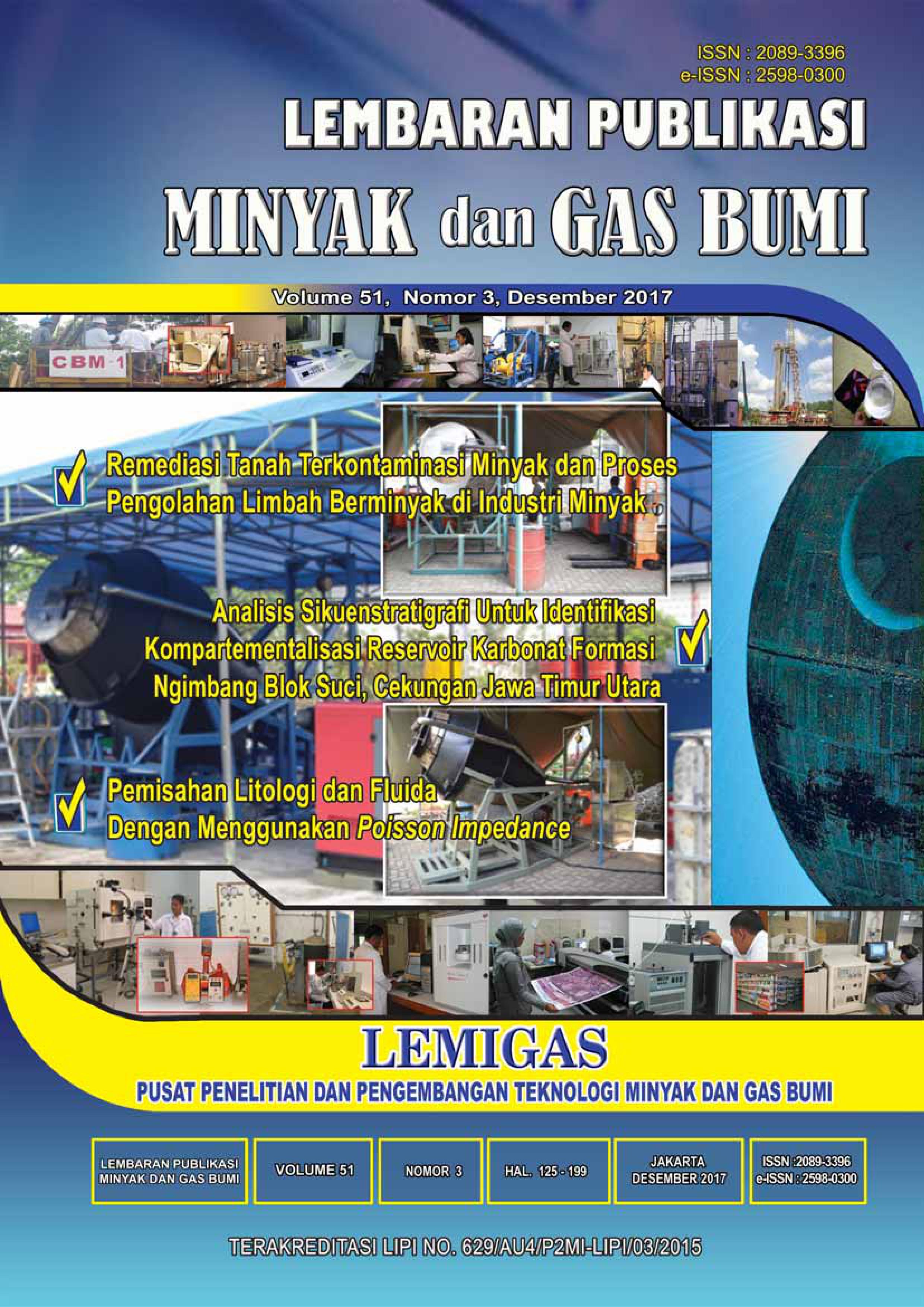PEMISAHAN LITOLOGI DAN FLUIDA DENGAN MENGGUNAKAN POISSON IMPEDANCE (Distinguishing Lithology and Fluid Using Poisson Impedance)
DOI:
https://doi.org/10.29017/LPMGB.51.3.25Kata Kunci:
poisson impedance, indeks litologi, indeks fluida, target correlation coefficient analysis, acoustic impedance, shear impedanceAbstrak
Parameter Acoustic Impedance (AI) dan Shear Impedance (SI) umumnya digunakan untuk sensitivitas pemisahan litologi dan fluida, distribusi properti petrofisika, pemodelan fasies, dan estimasi reserve potensi migas. Namun parameter tersebut tidak sensitif untuk pemisahan litologi dan fluida pada Formasi Plover di lapangan-X cekungan Bonaparte. Analisis lanjut parameter AI dan SI dilakukan dengan merotasikan kedua sumbu parameter tersebut ke dalam sumbu parameter yang baru sehingga menghasilkan parameter Poisson Impedance (PI) yang memenuhi persamaan PI = AI - c*SI. Pemisahan litologi dan fl uida dapat ditentukan dengan pemilihan nilai c yang berbeda melalui analisis TCCA (Target Correlation Coefficient Analysis). Nilai c untuk indeks litologi (LI) diperoleh dengan melakukan korelasi antara PI dan rekaman Gamma Ray (GR) dan untuk indeks fluida (FI) melalui korelasi antara PI dan Saturasi Air (Sw). Pada penelitian ini, terdapat dua zona target, yaitu zona A (3760 - 3920 meter) dan zona B (3920 - 4010 meter). Batas pemisahan litologi antara batupasir dan batu serpih menggunakan koefisien c = 1.245 untuk zona-A dan c = 2.3433 untuk zona-B sedangkan indikasi fluida menggunakan koefisien c = 2.740 untuk zona-A dan c = 3.2607 untuk zona-B.
Acoustic Impedance (AI) dan Shear Impedance (SI) parameters are frequently used for petrophysical properties distribution, facies modeling, and reserve calculation. However, these are less sensitive to distinguish lithology and fluid at the Plover formation of X-field, Bonaparte basin. More advanced approximation was conducted by rotating AI and SI axis paremeter to obtain Poisson Impedance (PI) satisfying an equation: PI = AI - c*SI. Different c constant was simulated by using Target Correlation Coefficient Analysis (TCCA) then each PI correlates to Gamma Ray and the best correlation indexed by Lithology Index while for PI versus Water Saturation indexed by Fluid Index. The upper target (zone A) leveled at interval 3760 - 3920 metre while the lower (zone B) at interval 3920 - 4010 metre. In the zone A, sandstone and shale lithology are separated on coefficient c = 1.245 and c = 2.3422 in the zone B meanwhile fluid is separated on c = 2.7400 and c = 3.2607 in the zona A and B, respectively.
Referensi
Direzza, A., I. K. Andika, and A. Permana, 2012. The Application of Poisson Impedance Inversion for Sandstone Reservoir Characterization in The Lower Talang, Akar Formation: AAPG International Convention and Exhibition, Search and Discovery Article 41080.
Hampson, D.P dan Russell, B.H, 2011. Seismic Lithology & AVO Workshop. CGG Veritas.
Inyang, N. J, Okwueze, E. E, O. E, Agbasi, 2015. Detection of Gas Sands in the Niger Delta by
Estimation of Poisson’s Dampening-Factor (PDF) Using Wireline Log Data, Geosciences p 46-51
Nagura, H. dkk, 2003. The Abadi gas fi eld: Proceeding Indonesian Petroleum Association, IPA-03, G-141
Ohara, M., Nakamura, K, dan Sasaki, Y., 2015, The Structural Evolution of Babar Selaru RegionIn The Southern Banda Outer Arc, Eastern Indonesia, IPA15-G-180, Proceedings Indonesian Petroleum Association, 39th Annual Conventionand Exhibition.
Quakenbush, M., B. Shang, and C. Tuttle, 2006. Poisson impedance: The Leading Edge, 25, no. 2, 128–138.
Setiawan, Satrio A, 2016. Karakterisasi Reservoir Batupasir dengan Menggunakan Metode Simultaneous Inversion, Skripsi Sarjana FMIPAUniversitas Indonesia.
Sitompul, Alexander. 2016. Karakterisasi Reservoar Karbonat dan Identifikasi Fluida Pengisi Pori Menggunakan Inversi Extended Elastic Impedance (EEI) Pada Lapangan “A”. Skripsi Sarjana FMIPAUniversitas Indonesia.
Sugiyono, 2007. Buku Statistika Untuk Penelitian. Penerbit CV Alfabeta, Bandung.
Sukmono, S. 1999. Buku Interpretasi Seismik Refl eksi. Teknik Geofi sika, Institut Teknologi Bandung.
Tian, L., D. Zhou, G. Lin, and L. Jiang, 2010, Reservoir prediction using Poisson Impedance in Quinhuangdao, Bohai Sea: SEG 80th Annual International Meeting, Expanded Abstracts, 2261–2264

